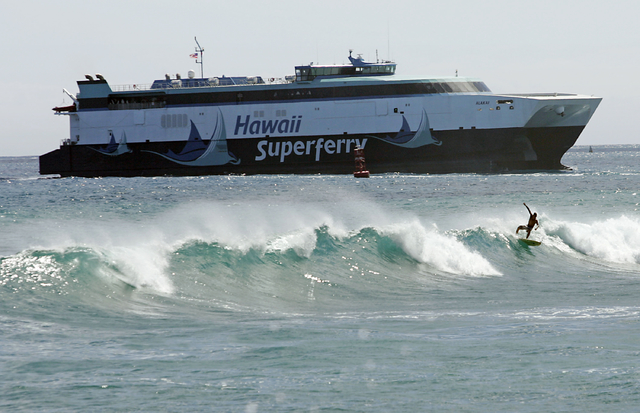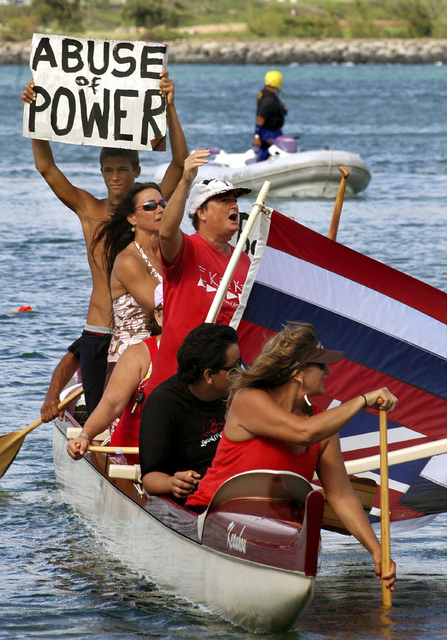HONOLULU — When a 30-foot-tall ferry loomed outside a Kauai harbor in 2007, surfers and kayakers — looking like tiny ducks in comparison — blocked its path, preventing it from unloading hundreds of passengers and sending the giant catamaran back to Oahu.
HONOLULU — When a 30-foot-tall ferry loomed outside a Kauai harbor in 2007, surfers and kayakers — looking like tiny ducks in comparison — blocked its path, preventing it from unloading hundreds of passengers and sending the giant catamaran back to Oahu.
The emotional standoff where surfers bobbed in the water for hours marked the end to an expensive failure in Hawaii’s history: the Superferry. Now the state is exploring bringing back a ferry to run between islands, facing skepticism over financing and whether there’s a ferry system residents would accept.
Lawmakers approved $50,000 in May to study a possible inter-island ferry, and the state Department of Transportation received a $500,000 grant from the federal Maritime Administration to hire consultants to explore potential routes and boats.
“The feasibility study might come back and say maybe it’s not financially feasible for us to do this,” said Ford Fuchigami, director of the state Transportation Department. “But right now, using federal money which is available … we want to be sure that we use that money to see whether or not this is possible.”
The Hawaii Superferry ran primarily between Oahu and Maui from 2007 until 2009, but was shut down after a judge ruled the state broke the law by not completing required environmental reviews.
It was a costly gamble. Hawaii spent at least $34 million on equipment for the ferry, which it later sold for just $425,000. The barges and ramps were custom-made for the Superferry, complicating the sale, said Tim Sakahara, Department of Transportation spokesman.
Hawaii Superferry filed for bankruptcy, leaving $136.8 million in debt to the Maritime Administration — which repossessed the ferries — and a $22.9 million debt to Austal USA, which built two ferries for Hawaii for $190 million. The Navy later paid the Maritime Administration just $35 million to buy both ships. One now serves as a ferry between Maine and Nova Scotia.
“In the beginning, people believed what they were reading, that it was going to be this really low-cost way to go inter-island and it sounded like a great thing,” said Irene Bowie, former executive director of the Maui Tomorrow Foundation, which opposed the ferry based on environmental concerns. “But the devil is always in the details.”
The new study will explore public or private ownership of vessels and operations. If the state owns the vessels, it could get federal subsidies, Fuchigami said. But it might be cheaper for a third party to operate a ferry system, he said.
“Almost no ferry system in the country is self-sustaining,” said Lauren Brand, an associate administrator for the Maritime Administration. “The vast majority of them have to have public dollars to help them keep on.”
Washington State’s ferry system, which Fuchigami has identified as a potential model for Hawaii, gets about 30 percent of its operating costs from subsidies and 70 percent from the fare box, ferry experts said. The Staten Island Ferry in New York, where customers ride for free, is also subsidized by taxpayers.
Hawaii’s open ocean geography, deadly channels and protected marine life pose unique challenges.
But Hawaii can learn from ferry systems operating in the Greek Islands, the Philippines and between Argentina and Uruguay, said David Moseley, a former director of Washington Ferries and senior consultant with Carus, a firm that may compete to conduct the Hawaii study.
“There are places all over the world where ferry systems with similar situations to Hawaii are operating very successfully,” Moseley added.
Fuchigami is considering a red-eye trip from Honolulu to Hawaii Island and inter-island trips from Oahu to Kauai and Maui. He also wants commuter ferries on Oahu and Maui.
“Everyone talks about traffic,” Fuchigami said, proposing a ferry from Oahu’s West side — where homes are less expensive — into urban Honolulu.
To ensure a steady revenue stream, Fuchigami hopes inter-island ferries could carry cargo such as farm produce.
“The main thing is that we’re going to be very, very careful,” Fuchigami said.
Superferry wasn’t the only failed sea vessel attempt in Hawaii. In 2009, the same year the Superferry shut down, Honolulu ended a passenger ferry service called “TheBoat” which shuttled passengers between downtown Honolulu and West Oahu for $2.
“It didn’t really attract ridership,” said Michael Hansen, president of the Hawaii Shippers Council. “Most of the people being carried were just tourists taking a boat ride.”
A ferry running from Molokai to Maui shut down this year amid financial losses.
The Sierra Club, which opposed the Superferry, worries ferries could spread invasive species and rapid ohia death, a fungal disease killing native ohia trees, said director Marti Townsend.
“If there is a way to operate a ferry that can guarantee against the spread of invasive species, then we will keep an open mind, but from what we know now, it’s an inherent fatal flaw,” she said.


